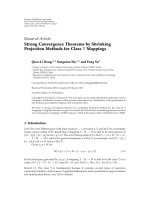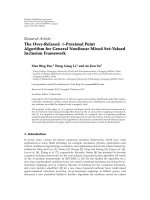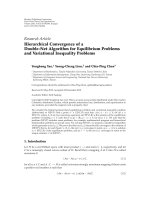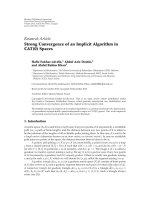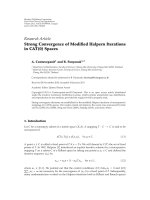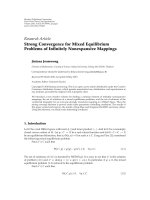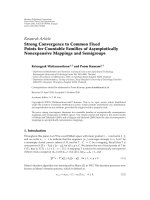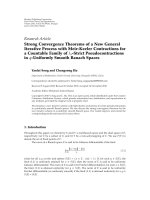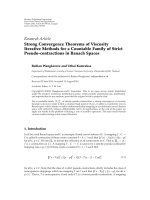Báo cáo hóa học: " Research Article Strong Convergence Theorem by Monotone Hybrid Algorithm for Equilibrium Problems, Hemirelatively Nonexpansive Mappings, and Maximal Monotone Operators" pdf
Bạn đang xem bản rút gọn của tài liệu. Xem và tải ngay bản đầy đủ của tài liệu tại đây (500.36 KB, 12 trang )
Hindawi Publishing Corporation
Fixed Point Theory and Applications
Volume 2008, Article ID 617248, 12 pages
doi:10.1155/2008/617248
Research Article
Strong Convergence Theorem by Monotone
Hybrid Algorithm for Equilibrium Problems,
Hemirelatively Nonexpansive Mappings, and
Maximal Monotone Operators
Yun Cheng and Ming Tian
College of Science, Civil Aviation University of China, Tianjin 300300, China
Correspondence should be addressed to Yun Cheng,
Received 17 June 2008; Accepted 11 November 2008
Recommended by Wataru Takahashi
We introduce a new hybrid iterative algorithm for finding a common element of the set of
fixed points of hemirelatively nonexpansive mappings and the set of solutions of an equilibrium
problem and for finding a common element of the set of zero points of maximal monotone
operators and the set of solutions of an equilibrium problem in a Banach space. Using this theorem,
we obtain three new results for finding a solution of an equilibrium problem, a fixed point of
a hemirelatively nonexpnasive mapping, and a zero point of maximal monotone operators in a
Banach space.
Copyright q 2008 Y. Cheng and M. Tian. This is an open access article distributed under the
Creative Commons Attribution License, which permits unrestricted use, distribution, and
reproduction in any medium, provided the original work is properly cited.
1. Introduction
Let E be a Banach space, let C be a closed convex subset of E,andletf be a bifunction from
C × C to R, where R is the set of real numbers. The equilibrium problem is to find
x
∗
∈ C such that fx
∗
,y ≥ 0 ∀y ∈ C. 1.1
The set of such solutions x
∗
is denoted by EPf.
In 2006, Martinez-Yanes and Xu 1 obtained strong convergence theorems for finding
a fixed point of a nonexpansive mapping by a new hybrid method in a Hilbert space. In
particular, Takahashi and Zembayashi 2 established a strong convergence theorem for
finding a common element of the set of solutions of an equilibrium problem and the set
of fixed points of a nonexpansive mapping in a uniformly convex and uniformly smooth
2 Fixed Point Theory and Applications
Banach space. Very recently, Su et al. 3 proved the following theorem by a monotone hybrid
method.
Theorem 1.1 see Su et al. 3. Let E be a uniformly convex and uniformly smooth real Banach
space, let C be a nonempty closed convex subset of E, and let T : C → C be a closed hemirelatively
nonexpansive mapping such that FT
/
∅. Assume that α
n
is a sequence in 0, 1 such that
lim sup
n →∞
α
n
< 1. Define a sequence x
n
in C by the following:
x
0
∈ C, chosen arbitrarily,
y
n
J
−1
α
n
Jx
n
1 − α
n
JTx
n
,
C
n
{z ∈ C
n−1
∩ Q
n−1
: φz, y
n
≤ φz, x
n
},
C
0
{z ∈ C : φz, y
0
≤ φz, x
0
},
Q
n
{z ∈ C
n−1
∩ Q
n−1
: x
n
− z, Jx
0
− Jx
n
≥0},
Q
0
C,
x
n1
Π
C
n
∩Q
n
x
0
,
1.2
where J is the duality mapping on E. Then, x
n
converges strongly to Π
FT
x
0
,whereΠ
FT
is the
generalized projection from C onto FT.
In this paper, motivated by Su et al. 3, we prove a strong convergence theorem
for finding a common element of the set of solutions of an equilibrium problem and the
set of fixed points of a hemirelatively nonexpansive mapping and for finding a common
element of the set of zero points of maximal monotone operators and the set of solutions
of an equilibrium problem in a Banach space by using the monotone hybrid method. Using
this theorem, we obtain three new strong convergence results for finding a solution of an
equilibrium problem, a fixed point of a hemirelatively nonexpnasive mapping, and a zero
point of maximal monotone operators in a Banach space.
2. Preliminaries
Let E be a real Banach space with dual E
∗
. We denote by J the normalized duality mapping
from E to 2
E
∗
defined by
Jx
f ∈ E
∗
: x, f x
2
f
2
, 2.1
where ·, · denotes the generalized duality pairing. It is well known that if E
∗
is uniformly
convex, then J is uniformly continuous on bounded subsets of E. In this case, J is single
valued and also one to one.
Let E be a smooth, strictly convex, and reflexive Banach space and let C be a nonempty
closed convex subset of E. Throughout this paper, we denote by φ the function defined by
φy, xy
2
− 2y, Jx x
2
. 2.2
Y. Cheng and M. Tian 3
Following Alber 4, the generalized projection Π
C
: E → C from E onto C is defined by
Π
C
xarg min
y∈C
φy, x ∀x ∈ E. 2.3
The generalized projection Π
C
from E onto C is well defined and single valued, and it satisfies
x−y
2
≤ φy, x ≤ x y
2
∀x, y ∈ E. 2.4
If E is a Hilbert space, then φy, xy − x
2
and Π
C
is the metric projection of E onto C.
If E is a reflexive strict convex and smooth Banach space, then for x, y ∈ E, φx, y0
if and only if x y.Itissufficient to show that if φx, y0, then x y.From2.4,
we have x y. This implies x, Jy x
2
Jy
2
. From the definition of J, we have
Jx Jy,thatis,x y.
Let C be a closed convex subset of E and let T be a mapping from C into itself.
We denote by FT the set of fixed points of T. T is called hemirelatively nonexpansive if
φp, Tx ≤ φp, x for all x ∈ C and p ∈ FT.
Apointp in C is said to be an asymptotic fixed point of T 5 if C contains a sequence x
n
which converges weakly to p such that the strong lim
n →∞
Tx
n
−x
n
0. The set of asymptotic
fixed points of T will be denoted by
FT. A hemirelatively nonexpansive mapping T from C
into itself is called relatively nonexpansive 1, 5, 6 if
FTFT.
We need the f ollowing lemmas for the proof of our main results.
Lemma 2.1 see Alber 4. Let C be a nonempty closed convex subset of a smooth, strictly convex,
and reflexive Banach space E. Then,
φ
x, Π
C
y
φ
Π
C
y, y
≤ φx, y ∀x ∈ C, y ∈ E. 2.5
Lemma 2.2 see Alber 4. Let C be a nonempty closed convex subset of a smooth, strictly convex,
and reflexive Banach space, let x ∈ E, and let z ∈ C. Then,
z Π
C
x ⇐⇒ y − z, Jx − Jz≤0 ∀y ∈ C. 2.6
Lemma 2.3 see Kamimura and Takahashi 7. Let E be a smooth and uniformly convex Banach
space and let {x
n
} and {y
n
} be sequences in E such that either {x
n
} or {y
n
} is bounded. If
lim
n →∞
φx
n
,y
n
0.Thenlim
n →∞
x
n
− y
n
0.
Lemma 2.4 see Xu 8. Let E be a uniformly convex Banach space and let r>0. Then, there exists
a strictly increasing, continuous, and convex function g : 0, 2r → R such that g00 and
tx 1 − ty
2
≤ tx
2
1 − ty
2
− t1 − tgx − y ∀x, y ∈ B
r
,t∈ 0, 1, 2.7
where B
r
{z ∈ E : z≤r}.
4 Fixed Point Theory and Applications
Lemma 2.5 see Kamimura and Takahashi 7. Let E be a smooth and uniformly convex Banach
space and let r>0. Then, there exists a strictly increasing, continuous, and convex function g :
0, 2r → R such that g00 and
gx − y ≤ φx, y ∀x, y ∈ B
r
. 2.8
For solving the equilibrium problem, let us assume that a bifunction f satisfies the
following conditions:
A1 fx, x0 for all x ∈ C;
A2 f is monotone, that is, fx, yfy, x ≤ 0 for all x, y ∈ C;
A3 for all x, y, z ∈ C, lim sup
t → 0
ftz 1 − tx, y ≤ fx, y;
A4 for all x ∈ C, f x, · is convex.
Lemma 2.6 see Blum and Oettli 9. Let C be a closed convex subset of a smooth, strictly convex,
and reflexive Banach space E,letf be a bifunction from C × C to R satisfying (A1)–(A4), let r>0,
and let x ∈ E. Then, there exists z ∈ C such that
fz, y
1
r
y − z, Jz − Jx≥0 ∀y ∈ C. 2.9
Lemma 2.7 see Takahashi and Zembayashi 10. Let C be a closed convex subset of a uniformly
smooth, strictly convex, and reflexive Banach space E,letf be a bifunction from C × C to R satisfying
(A1)–(A4), and let x ∈ E,forr>0 . Define a mapping T
r
: E → 2
C
as follows:
T
r
x
z ∈ C : fz, y
1
r
y − z, Jz − Jx≥0 ∀y ∈ C
∀x ∈ E. 2.10
Then, the following holds:
1 T
r
is single valued;
2 T
r
is a firmly nonexpansive-type mapping 11,thatis,forallx, y ∈ E,
T
r
x − T
r
y, JT
r
x − JT
r
y≤T
r
x − T
r
y, Jx − Jy; 2.11
3 FT
r
FT
r
Epf;
4 Epf is closed and convex.
Lemma 2.8 see Takahashi and Zembayashi 10. Let C be a closed convex subset of a smooth,
strictly convex, and reflexive Banach space E and let f be a bifunction from C × C to R satisfying
(A1)–(A4). Then, for r>0 and x ∈ E, and q ∈ FT
r
,
φq, T
r
xφT
r
x, x ≤ φq, x. 2.12
Y. Cheng and M. Tian 5
Lemma 2.9 see Su et al. 3. Let E be a strictly convex and smooth real Banach space, let C be
a closed convex subset of E, and let T be a hemirelatively nonexpansive mapping from C into itself.
Then, FT is closed and convex.
Recall that an operator T in a Banach space is called closed, if x
n
→ x, Tx
n
→ y, then
Tx y.
3. Strong convergence theorem
Theorem 3.1. Let E be a uniformly convex and uniformly smooth real Banach space, let C be a
nonempty closed convex subset of E,letf be a bifunction from C × C to R satisfying (A1)–(A4), and
let T : C → C be a closed hemirelatively nonexpansive mapping such that FT ∩ EPf
/
∅. Define
a sequence {x
n
} in C by the following:
x
0
∈ C, chosen arbitrarily,
y
n
J
−1
α
n
Jx
n
1 − α
n
JTz
n
,
z
n
J
−1
β
n
Jx
n
1 − β
n
JTx
n
,
u
n
∈ C such that fu
n
,y
1
r
n
y − u
n
,Ju
n
− Jy
n
≥0, ∀y ∈ C,
C
n
{z ∈ C
n−1
∩ Q
n−1
: φz, u
n
≤ φz, x
n
},
C
0
{z ∈ C : φz, u
0
≤ φz, x
0
},
Q
n
{z ∈ C
n−1
∩ Q
n−1
: x
n
− z, Jx
0
− Jx
n
≥0},
Q
0
C,
x
n1
Π
C
n
∩Q
n
x
0
,
3.1
for every n ∈ N ∪{0},whereJ is the duality mapping on E, {α
n
}, {β
n
} are sequences in 0, 1 such
that lim inf
n →∞
1 − α
n
β
n
1 − β
n
> 0 and {r
n
}⊂a, ∞ for some a>0. Then, {x
n
} converges
strongly to Π
FT∩EPf
x
0
,whereΠ
FT∩EPf
is the generalized projection of E onto FT ∩ EPf.
Proof. First, we can easily show that C
n
and Q
n
are closed and convex for each n ≥ 0.
Next, we show that FT ∩ EPf ⊂ C
n
for all n ≥ 0. Let u ∈ FT ∩ EPf. Putting
u
n
T
r
n
y
n
for all n ∈ N,fromLemma 2.8, we have T
r
n
relatively nonexpansive. Since T
r
n
are
relatively nonexpansive and T is hemirelatively nonexpansive, we have
φu, z
n
φu, J
−1
β
n
Jx
n
1 − β
n
JTx
n
u
2
− 2u, β
n
Jx
n
1 − β
n
JTx
n
β
n
Jx
n
1 − β
n
JTx
n
2
≤u
2
− 2β
n
u, Jx
n
−21 − β
n
u, JTx
n
β
n
x
n
2
1 − β
n
Tx
n
2
β
n
φu, x
n
1 − β
n
φu, Tx
n
≤ φu, x
n
,
φu, u
n
φu, T
r
n
y
n
≤ φu, y
n
≤ α
n
φu, x
n
1 − α
n
φu, z
n
≤ φu, x
n
.
3.2
6 Fixed Point Theory and Applications
Hence, we have
FT ∩ EPf ⊂ C
n
∀n ≥ 0. 3.3
Next, we show that FT ∩ EPf ⊂ Q
n
for all n ≥ 0. We prove this by induction. For n 0,
we have
FT ∩ EPf ⊂ Q
0
C. 3.4
Suppose that FT ∩ EPf ⊂ Q
n
,byLemma 2.2, we have
x
n1
− z, Jx
0
− Jx
n1
≥0 ∀z ∈ C
n
∩ Q
n
. 3.5
As FT ∩ EPf ⊂ C
n
∩ Q
n
, by the induction assumptions, the last inequality holds, in
particular, for all z ∈ FT ∩ EPf. This, together with the definition of Q
n1
, implies that
FT ∩ EPf ⊂ Q
n1
.So,{x
n
} is well defined.
Since x
n1
Π
C
n
∩Q
n
x
0
and C
n
∩ Q
n
⊂ C
n−1
∩ Q
n−1
for all n ≥ 1, we have
φx
n
,x
0
≤ φx
n1
,x
0
∀n ≥ 0. 3.6
Therefore, {φx
n
,x
0
} is nondecreasing. In addition, from the definition of Q
n
and Lemma 2.2,
x
n
Π
Q
n
x
0
. Therefore, for each u ∈ FT ∩ EPf, we have
φx
n
,x
0
φ
Π
Q
n
x
0
,x
0
≤ φu, x
0
− φu, x
n
≤ φu, x
0
. 3.7
Therefore, φx
n
,x
0
and {x
n
} are bounded. This, together with 3.6, implies that the limit of
{φx
n
,x
0
} exists. From Lemma 2.1, we have, for any positive integer m,
φx
nm
,x
n
φ
x
nm
, Π
Q
n
x
0
≤φx
nm
,x
0
−φ
Π
Q
n
x
0
,x
0
φx
nm
,x
0
−φx
n
,x
0
∀n ≥ 0.
3.8
Therefore,
lim
n →∞
φx
nm
,x
n
0. 3.9
From 3.9, we can prove that {x
n
} is a Cauchy sequence. Therefore, there exists a point x ∈ C
such that {x
n
} converges strongly to x.
Since x
n1
∈ C
n
, we have
φx
n1
,u
n
≤ φx
n1
,x
n
. 3.10
Therefore, we have
φx
n1
,u
n
−→ 0. 3.11
Y. Cheng and M. Tian 7
From Lemma 2.3, we have
lim
n →∞
x
n1
− u
n
lim
n →∞
x
n1
− x
n
0. 3.12
So, we have
lim
n →∞
x
n
− u
n
0. 3.13
Since J is uniformly norm-to-norm continuous on bounded sets, we have
lim
n →∞
Jx
n
− Ju
n
0. 3.14
Let r sup
n∈N
{x
n
, Tx
n
}. Since E is a uniformly smooth Banach space, we know that E
∗
is a uniformly convex Banach space. Therefore, from Lemma 2.4, there exists a continuous,
strictly increasing, and convex function g with g00, such that
αx
∗
1 − αy
∗
2
≤ αx
∗
2
1 − αy
∗
2
− α1 − αgx
∗
− y
∗
3.15
for x
∗
,y
∗
∈ B
r
,andα ∈ 0, 1. So, we have that for u ∈ FT ∩ EPf,
φu, z
n
φu, J
−1
β
n
Jx
n
1 − β
n
JTx
n
u
2
− 2u, β
n
Jx
n
1 − β
n
JTx
n
β
n
Jx
n
1 − β
n
JTx
n
2
≤ φu, x
n
− β
n
1 − β
n
gJx
n
− JTx
n
,
φu, u
n
≤ α
n
φu, x
n
1 − α
n
φu, z
n
≤ φu, x
n
− 1 − α
n
β
n
1 − β
n
gJx
n
− JTx
n
.
3.16
Therefore, we have
1 − α
n
β
n
1 − β
n
gJx
n
− JTx
n
≤ φu, x
n
− φu, u
n
. 3.17
Since
φu, x
n
− φu, u
n
x
n
2
−u
n
2
−2u, Jx
n
− Ju
n
≤x
n
−u
n
x
n
u
n
2uJx
n
−Ju
n
,
3.18
we have
lim
n →∞
φu, x
n
− φu, u
n
0. 3.19
From lim inf
n →∞
1 − α
n
β
n
1 − β
n
> 0, we have
lim
n →∞
gJx
n
− JTx
n
0. 3.20
8 Fixed Point Theory and Applications
Therefore, from the property of g, we have
lim
n →∞
Jx
n
− JTx
n
0. 3.21
Since J
−1
is uniformly norm-to-norm continuous on bounded sets, we have
lim
n →∞
x
n
− Tx
n
0. 3.22
Since T is a closed operator and x
n
→ x, then x is a fixed point of T.
On the other hand,
φu
n
,y
n
φT
r
n
y
n
,y
n
≤ φu, y
n
− φu, T
r
n
y
n
≤ φu, x
n
− φu, T
r
n
y
n
φu, x
n
− φu, u
n
.
3.23
So, we have from 3.19 that
lim
n →∞
φu
n
,y
n
0. 3.24
From Lemma 2.3, we have that
lim
n →∞
u
n
− y
n
0. 3.25
From x
n
→ x and x
n
− u
n
→0, we have y
n
→ x.
From 3.25, we have
lim
n →∞
Ju
n
− Jy
n
0. 3.26
From r
n
≥ a, we have
lim
n →∞
Ju
n
− Jy
n
r
n
0. 3.27
By u
n
T
r
n
y
n
, we have
fu
n
,y
1
r
n
y − u
n
,Ju
n
− Jy
n
≥0 ∀y ∈ C. 3.28
From A2, we have that
1
r
n
y − u
n
,Ju
n
− Jy
n
≥−fu
n
,y ≥ fy, u
n
∀y ∈ C. 3.29
Y. Cheng and M. Tian 9
From 3.27 and A4, we have
fy, x ≤ 0 ∀y ∈ C. 3.30
For t with 0 <t≤ 1andy ∈ C,lety
t
ty 1 − t x. We have fy
t
, x ≤ 0. So, from A1,we
have
0 fy
t
,y
t
≤ tfy
t
,y1 − tfy
t
, x ≤ tfy
t
,y. 3.31
Dividing by t, we have
fy
t
,y ≥ 0 ∀y ∈ C. 3.32
Letting t → 0, from A3, we have
f x, y ≥ 0 ∀y ∈ C. 3.33
Therefore, x ∈ EPf. Finally, we prove that x Π
FT∩EPf
x
0
.FromLemma 2.1, we have
φ
x, Π
FT∩EPf
x
0
φ
Π
FT∩EPf
x
0
,x
0
≤ φx, x
0
. 3.34
Since x
n1
Π
C
n
∩Q
n
x
0
and x ∈ FT ∩ EPf ⊂ C
n
∩ Q
n
, for all n ≥ 0, we get from Lemma 2.1
that
φ
Π
FT∩EPf
x
0
,x
n1
φx
n1
,x
0
≤ φ
Π
FT∩EPf
x
0
,x
0
. 3.35
By the definition of φx, y, it follows that φx, x
0
≤ φΠ
FT∩EPf
x
0
,x
0
and φx, x
0
≥
φΠ
FT∩EPf
x
0
,x
0
, whence φx, x
0
φΠ
FT∩EPf
x
0
,x
0
. Therefore, it follows from the
uniqueness of Π
FT∩EPf
x
0
that x Π
FT∩EPf
x
0
. This completes the proof.
Corollary 3.2. Let E be a uniformly convex and uniformly smooth real Banach space, let C be a
nonempty closed convex subset of E, and let f be a bifunction from C × C to R satisfying (A1)–(A4).
Define a sequence {x
n
} in C by the following:
x
0
∈ C, chosen arbitrarily,
u
n
∈ C such that fu
n
,y
1
r
n
y − u
n
,Ju
n
− Jx
n
≥0, ∀y ∈ C,
C
n
{z ∈ C
n−1
∩ Q
n−1
: φz, u
n
≤ φz, x
n
},
C
0
{z ∈ C : φz, u
0
≤ φz, x
0
},
Q
n
{z ∈ C
n−1
∩ Q
n−1
: x
n
− z, Jx
0
− Jx
n
≥0},
Q
0
C,
x
n1
Π
C
n
∩Q
n
x
0
,
3.36
10 Fixed Point Theory and Applications
for every n ∈ N ∪{0},whereJ is the duality mapping on E and {r
n
}⊂a, ∞ for some a>0. Then,
{x
n
} converges strongly to Π
EPf
x
0
.
Proof. Putting T I in Theorem 3.1,weobtainCorollary 3.2.
Corollary 3.3. Let E be a uniformly convex and uniformly smooth real Banach space, let C be a
nonempty closed convex subset of E, and let T : C → C be a closed hemirelatively nonexpansive
mapping. Define a sequence {x
n
} in C by the following:
x
0
∈ C, chosen arbitrarily,
y
n
J
−1
α
n
Jx
n
1 − α
n
JTz
n
,
z
n
J
−1
β
n
Jx
n
1 − β
n
JTx
n
,
u
n
Π
C
y
n
,
C
n
{z ∈ C
n−1
∩ Q
n−1
: Φz, u
n
≤ φz, x
n
},
C
0
{z ∈ C : φz, u
0
≤ φz, x
0
},
Q
n
{z ∈ C
n−1
∩ Q
n−1
: x
n
− z, Jx
0
− Jx
n
≥0},
Q
0
C,
x
n1
Π
C
n
∩Q
n
x
0
,
3.37
for every n ∈ N ∪{0},whereJ is the duality mapping on E, {α
n
}, {β
n
} are sequences in 0, 1 such
that lim inf
n →∞
1 − α
n
β
n
1 − β
n
> 0. Then, {x
n
} converges strongly to Π
FT
x
0
.
Proof. Putting fx, y0 for all x, y ∈ C and r
n
1 for all n in Theorem 3.1,weobtain
Corollary 3.3.
Corollary 3.4. Let E be a uniformly convex and uniformly smooth real Banach space, let C be a
nonempty closed convex subset of E,letf be a bifunction from C × C to R satisfying (A1)–(A4), and
let T : C → C be a closed relatively nonexpansive mapping such that FT ∩ EPf
/
∅. Define a
sequence {x
n
} in C by the following:
x
0
∈ C, chosen arbitrarily,
y
n
J
−1
α
n
Jx
n
1 − α
n
JTz
n
,
z
n
J
−1
β
n
Jx
n
1 − β
n
JTx
n
,
u
n
∈ C such that fu
n
,y
1
r
n
y − u
n
,Ju
n
− Jy
n
≥0, ∀y ∈ C,
C
n
{z ∈ C
n−1
∩ Q
n−1
: φz, u
n
≤ φz, x
n
},
C
0
{z ∈ C : φz, u
0
≤ φz, x
0
},
Q
n
{z ∈ C
n−1
∩ Q
n−1
: x
n
− z, Jx
0
− Jx
n
≥0},
Q
0
C,
x
n1
Π
C
n
∩Q
n
x
0
,
3.38
Y. Cheng and M. Tian 11
for every n ∈ N ∪{0},whereJ is the duality mapping on E, {α
n
}, {β
n
} are sequences in 0, 1 such
that lim inf
n →∞
1 − α
n
β
n
1 − β
n
> 0 and {r
n
}⊂a, ∞ for some a>0. Then, {x
n
} converges
strongly to Π
FT∩EPf
x
0
.
Proof. Since every relatively nonexpansive mapping is a hemirelatively one, Corollary 3.4 is
implied by Theorem 3.1.
Remark 3.5 see Rockafellar 12.LetE be a reflexive, strictly convex, and smooth Banach
space and let A be a monotone operator from E to E
∗
. Then, A is maximal if and only if
RJ rAE
∗
for all r>0.
Let E be a reflexive, strictly convex, and smooth Banach space and let A be a maximal
monotone operator from E to E
∗
.UsingRemark 3.5 and strict convexity of E,weobtainthat
for every r>0andx ∈ E, there exists a unique x
r
∈ DA such that Jx ∈ Jx
r
rAx
r
. If
J
r
x x
r
, then we can define a single-valued mapping J
r
: E → DA by J
r
J rA
−1
J,
and such a J
r
is called the resolvent of A.WeknowthatA
−1
0 FJ
r
for all r>0andJ
r
is relatively nonexpansive mapping see 2 for more details.UsingTheorem 3.1, we can
consider the problem of strong convergence concerning maximal monotone operators in a
Banach space.
Theorem 3.6. Let E be a uniformly convex and uniformly smooth real Banach space, let C be a
nonempty closed convex subset of E,letf be a bifunction from C × C to R satisfying (A1)–(A4), and
let J
r
be a resolvent of A and a closed mapping such that A
−1
0 ∩ EPf
/
∅,wherer>0. Define a
sequence {x
n
} in C by the following:
x
0
∈ C, chosen arbitrarily,
y
n
J
−1
α
n
Jx
n
1 − α
n
JJ
r
x
n
,
z
n
J
−1
β
n
Jx
n
1 − β
n
JJ
r
x
n
,
u
n
∈ C such that fu
n
,y
1
r
n
y − u
n
,Ju
n
− Jy
n
≥0, ∀y ∈ C,
C
n
{z ∈ C
n−1
∩ Q
n−1
: φz, u
n
≤ φz, x
n
},
C
0
{z ∈ C : φz, u
0
≤ φz, x
0
},
Q
n
{z ∈ C
n−1
∩ Q
n−1
: x
n
− z, Jx
0
− Jx
n
≥0},
Q
0
C,
x
n1
Π
C
n
∩Q
n
x
0
,
3.39
for every n ∈ N ∪{0},whereJ is the duality mapping on E, {α
n
} is a sequences in 0, 1 such that
lim inf
n →∞
1 − α
n
β
n
1 − β
n
> 0 and {r
n
}⊂a, ∞ for some a>0, Then, {x
n
} converges strongly
to Π
A
−1
0∩EPf
x
0
.
Proof. Since J
r
is a closed relatively nonexpansive mapping and A
−1
0 FJ
r
,from
Corollary 3.4,weobtainTheorem 3.6.
12 Fixed Point Theory and Applications
Acknowledgment
This work is supported by Tianjin Natural Science Foundation in China Grant no.
06YFJMJC12500.
References
1 C. Martinez-Yanes and H K. Xu, “Strong convergence of the CQ method for fixed point iteration
processes,” Nonlinear Analysis: Theory, Methods & Applications, vol. 64, no. 11, pp. 2400–2411, 2006.
2 W. Takahashi and K. Zembayashi, “Strong convergence theorem by a new hybrid method for
equilibrium problems and relatively nonexpansive mappings,” Fixed Point Theory and Applications,
vol. 2008, Article ID 528476, 11 pages, 2008.
3 Y. Su, D. Wang, and M. Shang, “Strong convergence of monotone hybrid algorithm for hemi-relatively
nonexpansive mappings,” Fixed Point Theory and Applications, vol. 2008, Article ID 284613, 8 pages,
2008.
4 Y. I. Alber, “Metric and generalized projection operators in Banach spaces: properties and
applications,” in Theory and Applications of Nonlinear Operators of Accretive and Monotone Type,A.G.
Kartsatos, Ed., vol. 178 of Lecture Notes in Pure and Applied Mathematics, pp. 15–50, Marcel Dekker,
New York, NY, USA, 1996.
5 D. Butnariu, S. Reich, and A. J. Zaslavski, “Asymptotic behavior of relatively nonexpansive operators
in Banach spaces,” Journal of Applied Analysis, vol. 7, no. 2, pp. 151–174, 2001.
6 S Y. Matsushita and W. Takahashi, “A strong convergence theorem for relatively nonexpansive
mappings in a Banach space,” Journal of Approximation Theory, vol. 134, no. 2, pp. 257–266, 2005.
7 S. Kamimura and W. Takahashi, “Strong convergence of a proximal-type algorithm in a Banach
space,” SIAM Journal on Optimization, vol. 13, no. 3, pp. 938–945, 2002.
8 H. K. Xu, “Inequalities in Banach spaces with applications,” Nonlinear Analysis: Theory, Methods &
Applications, vol. 16, no. 12, pp. 1127–1138, 1991.
9 E. Blum and W. Oettli, “From optimization and variational inequalities to equilibrium problems,” The
Mathematics Student, vol. 63, no. 1–4, pp. 123–145, 1994.
10 W. Takahashi and K. Zembayashi, “Strong and weak convergence theorems for equilibrium problems
and relatively nonexpansive mappings in Banach spaces,” Nonlinear Analysis: Theory, Methods &
Applications, vol. 70, no. 1, pp. 45–57, 2009.
11 F. Kohsaka and W. Takahashi, “Existence and approximation of fixed points of firmly nonexpansive
type mappings in Banach spaces,” to appear in SIAM Journal on Optimization.
12 R. T. Rockafellar, “On the maximality of sums of nonlinear monotone operators,” Transactions of the
American Mathematical Society, vol. 149, pp. 75–88, 1970.
